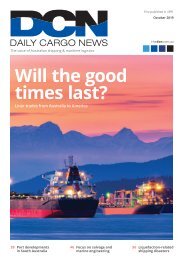DCN0718_Combined_150
You also want an ePaper? Increase the reach of your titles
YUMPU automatically turns print PDFs into web optimized ePapers that Google loves.
TRADE MINISTER COMMENT<br />
The Trans-Pacific Partnership:<br />
seizing the day<br />
Steven Ciobo, minister for trade, tourism and investment, discusses how TPP-11<br />
will further enable businesses to benefit from regional value chains<br />
THE COMPREHENSIVE AND<br />
Progressive Agreement for Trans-Pacific<br />
Partnership, or TPP-11, is a highly<br />
ambitious free trade agreement (FTA)<br />
signed on 8 March 2018 by Australia,<br />
Brunei, Canada, Chile, Japan, Malaysia,<br />
Mexico, New Zealand, Peru, Singapore<br />
and Vietnam. It is set to provide new<br />
opportunities for Australian exporters<br />
and importers as well as shippers,<br />
customs brokers and freight forwarders.<br />
The TPP-11 will liberalise more than<br />
98% of tariffs in a trade area that has a<br />
GDP of $13.7 trillion and encompasses<br />
nearly 500m consumers. The Turnbull<br />
government is working hard to ensure<br />
our businesses can take advantage of the<br />
deal as soon as possible.<br />
THE IMPACT OF THE TPP-11<br />
The TPP-11 is much more than a<br />
traditional tariff-cutting deal – this<br />
agreement will dismantle some of the<br />
most persistent barriers to free trade. It<br />
has a single set of rules of origin, allowing<br />
exporters to complete one standard set of<br />
documentation to claim preferential tariff<br />
treatment within the TPP-11 market, and<br />
will allow producers to self-certify.<br />
The agreement includes modern<br />
rules that will provide certainty to<br />
traders when liaising with customs<br />
authorities. It will also provide certainty<br />
around customs processes by allowing<br />
for advance rulings on the tariff<br />
classification of a good; how it should<br />
be valued; from where the good is<br />
originating and how to claim preference;<br />
and independent review of decisions by<br />
customs authorities.<br />
For the first time in a regional<br />
agreement, duty-free entry will be given<br />
to the temporary entry of containers<br />
and pallets involved in transporting<br />
goods. This will reduce costs considerably<br />
for Australian exporters and transport<br />
companies, who currently pay duties as<br />
high as 20% in some TPP-11 countries.<br />
Malaysia has also guaranteed its current<br />
investment regime for freight transport<br />
(with a foreign equity regime of 49%)<br />
and has guaranteed that any future<br />
market reforms will flow through to<br />
Australian producers.<br />
In addition, the TPP-11 promotes high<br />
quality standards for the treatment of<br />
express shipments, including courier<br />
services. It encourages the provision of<br />
information before a shipment arrives<br />
and demands minimal documentation<br />
requirements. The TPP-11 encourages<br />
the adoption of simplified customs<br />
procedures, thereby reducing the time<br />
taken to clear goods by allowing advance<br />
electronic submission and processing<br />
of customs information and allowing<br />
goods to be released before the final<br />
determination of customs duties.<br />
The TPP-11 will further enable<br />
Australian businesses to benefit from<br />
regional value chains. It does so by<br />
allowing countries to specialise in<br />
their respective areas of comparative<br />
advantage, which in turn delivers a boost<br />
in productivity and extra income for<br />
Australian businesses.<br />
This agreement, at its core, operates<br />
on the principles of openness, fair<br />
competition and transparency. The scope<br />
of this deal and its level of ambition<br />
cannot be underestimated. The TPP-11 will<br />
have a major impact on our region’s trade<br />
and economic landscape, and its reach will<br />
naturally expand as more countries sign<br />
up for membership, increasing the size and<br />
significance of the agreement.<br />
SO WHAT’S NEXT?<br />
The TPP-11 is currently undergoing<br />
parallel parliamentary review processes<br />
Above: Steven Ciobo, minister for trade,<br />
tourism and investment<br />
This agreement, at its core, operates on the principles<br />
of openness, fair competition and transparency<br />
in the countries it covers. The<br />
agreement is to enter into force<br />
60 days after six of the 11 signatories<br />
have ratified the agreement. It is<br />
important that Australia is a part of<br />
this first wave of countries that ratify<br />
the new agreement. The government<br />
is focused on concluding Australia’s<br />
domestic treaty-making processes as<br />
swiftly as possible.<br />
GETTING THE BENEFITS<br />
To make it easier for Australian<br />
businesses to enjoy the benefits of FTAs,<br />
the FTA Portal (ftaportal.dfat.gov.<br />
au/), maintained by the Department<br />
of Foreign Affairs and Trade, can help<br />
importers and exporters understand<br />
which FTA suits their business best.<br />
And, for more information on the<br />
TPP-11, please visit dfat.gov.au/trade/<br />
agreements/not-yet-in-force/tpp-11.<br />
Image supplied<br />
16<br />
First published in 1891<br />
July 2018<br />
thedcn.com.au

















